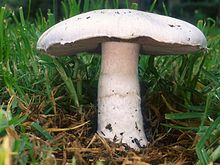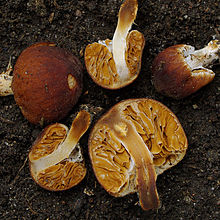Agaricales
| Agaricales Temporal range: Upper Aptian–Holocene,
| |
|---|---|

| |
| Agaricus campestris (Agaricaceae) | |
| Scientific classification | |
| Domain: | Eukaryota |
| Kingdom: | Fungi |
| Division: | Basidiomycota |
| Class: | Agaricomycetes |
| Subclass: | Agaricomycetidae |
| Order: | Agaricales Underw. (1899)[2] |
| Subdivisions | |
| Synonyms[3] | |
|
Amanitales Jülich (1981) | |
The fungal order Agaricales, also known as gilled mushrooms (for their distinctive gills) or euagarics, contains some of the most familiar types of mushrooms. The order has 33 extant families, 413 genera, and over 13,000 described species,[4] along with six extinct genera known only from the fossil record.[5][6][1] They range from the ubiquitous common mushroom to the deadly destroying angel and the hallucinogenic fly agaric to the bioluminescent jack-o-lantern mushroom.
History, classification and phylogeny
| |||||||||||||||||||||||||||||||||||||||||||||||||||||||||||||||||||||||||||||||||||||||||||||||||||||||||||||||||||||
| Cladogram of the Agaricales, showing the division into six major clades, based on Matheny et al., 2006.[7] |
In his three volumes of Systema Mycologicum published between 1821 and 1832, Elias Fries put almost all of the fleshy, gill-forming mushrooms in the genus Agaricus. He organized the large genus into "tribes", the names of many of which still exist as common genera of today. Fries later elevated several of these tribes to generic level, but later authors—including Gillet, Karsten, Kummer, Quélet, and Staude—made most of the changes. Fries based his classification on macroscopic characters of the fruit bodies and color of the spore print. His system had been widely used as it had the advantage that many genera could be readily identified based on characters observable in the field. Fries's classification was later challenged when microscopic studies of basidiocarp structure, initiated by Fayod and Patouillard, demonstrated several of Fries's groupings were unnatural.[4] In more recent history, Rolf Singer's influential work The Agaricales in Modern Taxonomy, published in four editions spanning from 1951 to 1986, used both Fries's macroscopic characters and Fayod's microscopic characters to reorganize families and genera; his most recent classification included 230 genera within 18 families.[8] Singer treated three major groups within the Agaricales sensu lato: the Agaricales sensu stricto, Boletineae, and Russulales. These groups are still accepted by modern treatments based on DNA analysis, as the euagarics clade, bolete clade, and russuloid clade.[9]

Molecular phylogenetics research has demonstrated that the euagarics clade is roughly equivalent to Singer's Agaricales sensu stricto.[10][11][12] A recent (2006) large-scale study by Brandon Matheny and colleagues used nucleic acid sequences representing six gene regions from 238 species in 146 genera to explore the phylogenetic grouping within the Agaricales. The analysis showed that most of the species tested could be grouped into six clades that were named the Agaricoid, Tricholomatoid, Marasmioid, Pluteoid, Hygrophoroid and Plicaturopsidoid clades.[7]
Some notable fungi with gill-like structures, such as chanterelles, have long been recognized as being substantially different from usual Agaricales. Molecular studies are showing more groups of agarics as being more divergent than previously thought, such as the genera Russula and Lactarius belonging to a separate order Russulales, and other gilled fungi, including such species as Paxillus involutus and Hygrophoropsis aurantiaca showing a closer affinity with boletes in the order Boletales.
Also, some other quite distinctive fungi, the puffballs, and some clavaroid fungi, e.g. Typhula, and the beefsteak fungus have been recently been shown to lie within the Agaricales.
The term agaric had traditionally referred to Agaricales, which were defined as exactly those fungi with gills. Given the discoveries described above, those two categories are not synonymous (although there is a very large overlap between the two groups).
Distribution and habitat
Agarics are ubiquitous, being found across all continents. Most are terrestrial, their habitats including all types of woodland and grassland, varying largely from one genus to another. Agarics were long thought to be solely terrestrial, until the 2005 discovery of Psathyrella aquatica, the only gilled mushroom known to fruit underwater.[13]
Agaricals are known from six monotypic fossil genera mostly found fossilized in amber. The oldest records are from three Cretaceous age genera; the late Aptian Gondwanagaricites magnificus from the Crato Formation (Brazil),[1] the Albian age (approximately 100 Ma) Palaeoagaracites antiquus from Burmese amber and the slightly younger Turonian New Jersey Amber species Archaeomarasmius leggeti.[5] The three other species, Aureofungus yaniguaensis, Coprinites dominicana and Protomycena electra are known from single specimens found in the Dominican amber mines of Hispaniola.[6]
Characteristics
Basidiocarps of the agarics are typically fleshy, with a stipe, often called a stem or stalk, a pileus (or cap) and lamellae (or gills), where basidiospores are produced. This is the stereotypical structure of a mushroom. Different types of mushrooms include the polypores, they have pores (tubes) rather than gills, and the hydnoid fungi that form tooth-like or spine-like projections.

Life cycle
The fungus fruit body is the spore-producing stage of the life cycle. Most fungi reproduce by spores and the fruit bodies are developed specifically for the production and dispersal of spores. The spores produced by fruit bodies are usually the result of sexual reproduction.[14]
The fruit body is the visible part of the growing fungus. It is supported by and develops from an extensive network of thread-like filaments called hyphae. Hyphae are often collectively termed the mycelium; the food-absorbing part of the fungus—as opposed to the spore-producing fruit body of the fungus—is called the vegetative mycelium. The individual hyphae that compose the mycelium absorb nutrients and water from the substratum in which they are growing. When the nutrient supply is adequate and environmental conditions are favorable, some fungi may grow in the same location for several years. Fungi cannot make their own food, namely carbohydrates, as can green plants. Some species are saprobic, obtaining nutrients from dead organic material, whereas others are parasitic on living plants or animals or even on other fungi. Many fungi, especially gilled mushrooms and boletes, have an extensive mycelium that lives in association with the roots of woody plants. This association, which is beneficial to both the fungus and host plant, is termed a mycorrhiza.[14]
When the environmental conditions are favorable and the mycelium is at the proper stage of development, one or more fruit bodies are produced by the fungus. The actual conditions necessary for fruit body formation and spore production are not clearly understood. Humidity, light, temperature, aeration, and nutrition are all factors thought to be important in fruit body formation. The genetic makeup and the general physiology of the fungus hyphae are also important in the initiation and formation of young fruit bodies and their development to a mature stage. The spores produced by a fruit body are released when it is mature. When they land in a suitable environment, the spores germinate and the hyphae grow to initiate the life cycle anew.[14]
Genera Incertae sedis

There are several genera classified in the Agaricales that are i) poorly known, ii) have not been subjected to DNA analysis, or iii) if analysed phylogenetically do not group with as yet named or identified families, and have not been assigned to a specific family (i.e., Incertae sedis with respect to familial placement). These include:
- †Aureofungus Hibbett, Manfr. Binder & Zheng Wang (2003)
- Brunneocorticium Sheng H.Wu (2007)
- Cheilophlebium Opiz & Gintl (1856)
- Cleistocybe Ammirati, A.D.Parker & Matheny (2007)
- Cribrospora Pacioni & P.Fantini (2000)
- Disporotrichum (anamorph) Stalpers (1984)
- Hemistropharia Jacobsson & E. Larss. (2007)[15]
- Mesophelliopsis Bat. & A.F.Vital (1957)
- †Palaeoagaracites Poinar & Buckley (2007)
- Panaeolina Maire (1933)
- Panaeolus (Fr.) Quél. (1872)
- Phlebophyllum R.Heim (1969)
- Plicatura Peck (1872)
- Sedecula Zeller (1941)
- Setchelliogaster Pouzar (1958)
- Trichocybe Vizzini (2010)
See also
References
- ^ a b c Heads, Sam W.; Miller, Andrew N.; Crane, J. Leland; Thomas, M. Jared; Ruffatto, Danielle M.; Methven, Andrew S.; Raudabaugh, Daniel B.; Wang, Yinan (2017). "The oldest fossil mushroom". PLOS ONE. 12 (6): e0178327. Bibcode:2017PLoSO..1278327H. doi:10.1371/journal.pone.0178327. PMC 5462346. PMID 28591180.
- ^ Underwood LM. (1899). Moulds, mildews and mushrooms: a guide to the systematic study of the Fungi and Mycetozoa and their literature. New York, New York: Henry Holt. p. 97.
- ^ "Agaricales Underw. 1899". MycoBank. International Mycological Association. Retrieved 2010-12-30.
- ^ a b Kirk PM, Cannon PF, Minter DW, Stalpers JA (2008). Dictionary of the Fungi (10th ed.). Wallingford, UK: CABI. p. 12. ISBN 978-0-85199-826-8.
- ^ a b Poinar GO, Buckley R (2007). "Evidence of mycoparasitism and hypermycoparasitism in Early Cretaceous amber". Mycological Research. 111 (4): 503–506. doi:10.1016/j.mycres.2007.02.004. PMID 17512712.
- ^ a b Hibbett DS, Binder M, Wang Z, Goldman Y (2003). "Another Fossil Agaric from Dominican Amber". Mycologia. 95 (4): 685–687. doi:10.2307/3761943. JSTOR 3761943. PMID 21148976.(subscription required)
- ^ a b Matheny PB, Curtis JM, Hofstetter V, Aime MC, Moncalvo JM, Ge ZW, Slot JC, Ammirati JF, Baroni TJ, Bougher NL, Hughes KW, Lodge DJ, Kerrigan RW, Seidl MT, Aanen DK, DeNitis M, Daniele GM, Desjardin DE, Kropp BR, Norvell LL, Parker A, Vellinga EC, Vilgalys R, Hibbett DS (2006). "Major clades of Agaricales: a multilocus phylogenetic overview" (PDF). Mycologia. 98 (6): 982–95. doi:10.3852/mycologia.98.6.982. PMID 17486974. Archived from the original (PDF) on 2016-03-03.
- ^ Singer R. (1986). The Agaricales in Modern Taxonomy (4th ed.). Koenigstein Königstein im Taunus, Germany: Koeltz Scientific Books. ISBN 978-3-87429-254-2.
- ^ Hibbett DH, Thorn RG. "Basidiomycota: Homobasidiomycetes". In McLaughlin DJ, McLaughlin EG, Lemke PA (eds.). The Mycota. VIIB. Systematics and Evolution. Springer-Verlag. pp. 121–68. ISBN 978-3-540-58008-9.
- ^ Hibbett DS, Pine EM, Langer E, Langer G, Donoghue MJ (1997). "Evolution of gilled mushrooms and puffballs inferred from ribosomal DNA sequences". Proceedings of the National Academy of Sciences of the United States of America. 94 (22): 12002–6. Bibcode:1997PNAS...9412002H. doi:10.1073/pnas.94.22.12002. PMC 23683. PMID 9342352.
- ^ Moncalvo JM, Lutzoni FM, Rehner SA, Johnson J, Vilgalys R (2000). "Phylogenetic relationships of agaric fungi based on nuclear large subunit ribosomal DNA sequences". Systematic Biology. 49 (2): 278–305. doi:10.1093/sysbio/49.2.278. PMID 12118409.
- ^ Moncalvo JM, Vilgalys R, Redhead SA, Johnson JE, James TY, Catherine Aime M, Hofstetter V, Verduin SJ, Larsson E, Baroni TJ, Greg Thorn R, Jacobsson S, Clémençon H, Miller OK (2002). "One hundred and seventeen clades of euagarics" (PDF). Molecular Phylogenetics and Evolution. 23 (3): 357–400. doi:10.1016/S1055-7903(02)00027-1. PMID 12099793.
- ^ Frank JL, Coffan RA, Southworth D (2010). "Aquatic gilled mushrooms: Psathyrella fruiting in the Rogue River in southern Oregon". Mycologia. 102 (1): 93–107. doi:10.3852/07-190. PMID 20120233. S2CID 7175296.
- ^ a b c Alexopolous et al., pp. 508–43.
- ^ Jacobsson S, Larsson E (2007). "Hemistropharia, a new genus in Agaricales". Mycotaxon. 102: 235–40.
Cited texts
- Alexopoulos CJ, Mims CW, Blackwell M (1996). Introductory Mycology. John Wiley and Sons. ISBN 978-0-471-52229-4.
External links
- Mushroom Expert The Gilled Mushrooms ("Agaricales")
- Tree of Life: Agaricales
